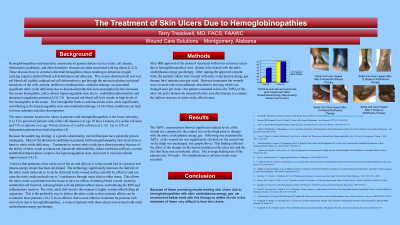Clinical Research
(CR-081) Treatment of Skin Ulcers Due to Hemoglobinopathies

Hemoglobinopathies and hemolytic anemia due to genetic defects such as sickle cell disease, thalassemia syndromes, and other hemolytic diseases are often associated with leg ulcers. These diseases have in common abnormal hemoglobin chains resulting in abnormal oxygen carrying capacity and red blood cell deformation and adhesion, This causes shortened cell survival, red blood cell rigidity, reduced red cell deformation to get through the microcirculation, increased hemolysis of the cells, anemia, ineffective erythropoiesis, oxidative damage, an associated significant nitric oxide deficiency due to decreased production and consumption by the increased free serum hemoglobin, and a chronic hypercoagulable state due to endothelial abnormalities and abnormal coagulation proteins. These conditions can lead to tissue ischemia and ulcer development.
The most common location for ulcers in patients with hemoglobinopathies is the lower extremity. Five percent of patients with sickle cell disease who were over age 10 had a history of a sickle cell ulcer and 75% of patients over age 30 had a history of a sickle cell ulcer. Up to 22% of thalassemia patients have had a leg ulcer.
Methods:
Because the underlying etiology is a genetic abnormality, current therapies have generally proven inadequate. Most of the abnormal conditions in patients with hemoglobinopathy skin ulcers have a basis in nitric oxide deficiency, treatment with nitric oxide/plasma energy therapy was investigated. The combination of gaseous nitric oxide and plasma energy overcomes the short half-life of the nitric oxide molecule allowing the nitric oxide energy stream to penetrate up to 3 cm through intact skin providing effective treatment.
Results:
A series of 5 patients with sickle cell ulcers was treated with gaseous nitric oxide/plasma energy therapy for 6 minutes once per week for 4 weeks. This microcirculation showed significant improvement as demonstrated with increased TcPO2 levels. Healing was significantly improved at 4 weeks compared to patients not treated with the gaseous nitric oxide/plasma energy therapy.
Discussion: x
Because of these promising results treating these skin ulcers with nitric oxide/plasma energy, we recommend further trials with this therapy to define its role in the treatment of these very difficult to heal skin ulcers.

.jpg)